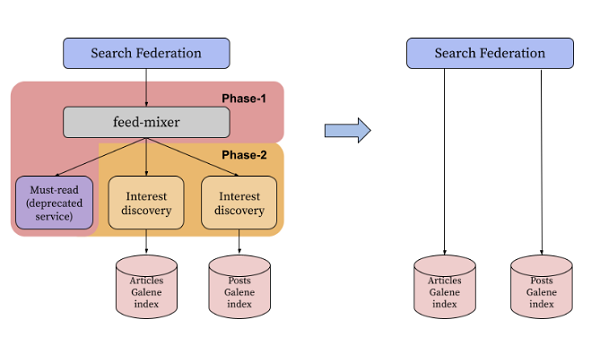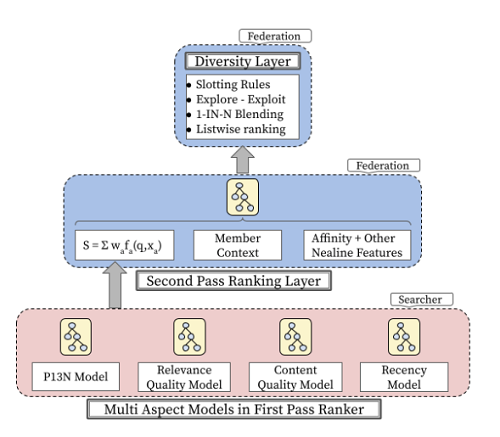Looking to get a better handle on LinkedIn, and how its algorithms surface certain content in different forms?
Today, LinkedIn has shared a new overview of how it’s refining its search and discovery elements, with its search algorithm now putting less focus on alignment to your noted interests over time, and more on maximizing broader discovery, while also incorporating diversity considerations into the mix.
As explained by LinkedIn:
“Post search saw strong organic growth in 2020, with a 35% year-over-year increase in user engagement. As we watched content continue to grow and diversify on the platform, the Flagship Search team saw an opportunity to improve the Post search tech stack’s agility, with a strategic priority to enable members to create, find, share, and have productive conversations around high-quality content on LinkedIn.”
As engagement levels have continued to rise in the app, it’s been working to surface more relevant, engaging content, to keep people commenting and interacting, which has led to a re-thinking of how its search tools highlight matches, in order to improve those stats.
As a result, LinkedIn says that it has now re-imagined its search architecture, and removed certain elements that restricted the results you’d see:
“The first phase removed feed-mixer from the call stack and moved fanout and blending into the search federator. The second phase removed interest-discovery. This enabled us to get rid of all the cruft built up over the years and simplified the stack by removing additional layers of data manipulation.”

Okay, these more technical explanations can get painful (trust me, I know), but basically, what’s happened is that LinkedIn has eliminated some of the elements that narrowed your search results based on your noted interests, which LinkedIn’s system had established over time, based on your engagement patterns.
Up till now, you’d have been more likely to see content posted by people working in certain sectors or on specific topics. But now, the system will take a broader view of content from across the app to show you a wider scope of possible matches, which will also help LinkedIn highlight more engaging content from all users.
Which is similar to the approach that TikTok takes, in highlighting engaging content from across the app in its ‘For You’ feed, as opposed to restricting what it can display based on who you’ve chosen to follow. This expanded approach facilitates even more engagement and interaction, because the system has more scope to show you the best content from anyone, as opposed to filtering things down based on your more personally refined scope.
Which could also make the results less relevant – though LinkedIn says that it’s also accounted for this:

As you can see in this new and improved search algorithm matrix, member context remains a key consideration, but it also incorporates more elements to improve the quality of its expanded search results.
LinkedIn has also built in a new diversity element to ensure more exposure to a wider breadth of creators.
“The Diversity re-ranker forms our last layer and helps us inject diverse content in the top positions. This includes increasing discovery of potentially viral content for trending queries, reducing duplication of similar content, etc.”
The end result is that users are being shown a wider breadth of content relevant to their query, while LinkedIn is also helping to amplify members from more diverse background within its display.
Which has led to significant engagement improvements.
“Pertinent results, which are highly relevant to the user’s search query, have led to an aggregate click-through rate improvement of over 10%. Increased distribution of posts from within the searcher’s social network, their geographic location, and in their preferred language have led to a 20% increase in messaging within the searcher’s network.”
So more members are getting more direct messages as a result of these changes, along with the noted engagement improvements.
But LinkedIn’s not done refining its search results yet.
The platform’s also working on highlighting more topical results within search results, in order to help users tap into related, trending topics, while it’s also testing ways to better highlight content from prominent LinkedIn creators.
“Results are ranked today mainly by using viewer-side utility functions such as likelihood of a click, user action originating from search, etc. To support our creators, we will evolve this ranking, along with our experimentation and testing stack, to also optimize for creator-side utilities, such as content creation or distribution for emerging creators.”
Promoting creators has become a key focus for all social networks, including LinkedIn, which has been working on new tools and elements to help creators build their audience in the app, including improved profile video tools, new analytics insights, newsletters, live videos, and more.
Eventually, according to these notes, that will also see these creators get a search boost as well, which could be another way to incentivize more dedicated LinkedIn community building.
It’s interesting to note how LinkedIn is looking to reform its Search tools, and to consider what that means for discovery in the app. For the most part, it should be beneficial, with the expanded Search breadth helping more users connect with posts and people beyond their immediate network, though it may also lead to some changes in your discovery stats, because of that shift.
Either way, it’s worth noting in your LinkedIn creation process. And with the platform continuing to see ‘record levels’ of engagement, it may well be worth paying more attention to your LinkedIn engagement, and considering how these search updates may influence your performance.
You can read LinkedIn’s full ‘Improving Post Search’ overview here.



